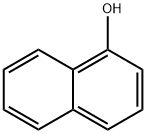1-Naphthol: Natural Occurrence and its Catabolism via Synergistic Regulation
May 17,2024
General Description
1-Naphthol, a derivative of naphthol, serves as a genotoxin and human xenobiotic metabolite, naturally occurring in plants like Selaginella sinensis, Juglans nigra, and Magnolia liliiflora. Its presence underscores its ecological and biochemical significance in these species. Widely used in organic synthesis, 1-Naphthol is also recognized as an organic pollutant due to its toxicity. Microbial studies reveal its complex catabolic pathways, especially when coexisting with primary carbon sources like glucose, showcasing a synergistic regulatory mechanism. Understanding these pathways offers insights into environmental microbiology and bioremediation strategies for toxic pollutants. In summary, 1-Naphthol's diverse roles span ecological interactions, biochemical processes, and environmental impacts, highlighting its significance in various fields of study.

Figure 1. 1-Naphthol
Overview
1-Naphthol is a derivative of naphthol featuring a hydroxy group at position 1. It functions as a genotoxin and a human xenobiotic metabolite. Found naturally in plants like Selaginella sinensis and Juglans nigra, 1-Naphthol plays a crucial role in various metabolic pathways, including the metabolism of xenobiotics by cytochrome P450 enzymes. Despite its transient presence in the body, it serves as a reliable indicator of exposure to substances like chlorpyrifos, a widely used insecticide. Studies suggest associations between 1-Naphthol and reduced testosterone levels in adult men. 1
Natural Occurrence
1-Naphthol, also known as α-naphthol, is a naturally occurring compound found in several plant species, including Selaginella sinensis, Juglans nigra (black walnut), and Magnolia liliiflora. Its presence in these plants has been confirmed through available data and research. Selaginella sinensis, commonly known as Chinese spikemoss, is a type of fern ally native to China and other parts of Asia. Studies have identified 1-Naphthol in this plant, suggesting a role in its biological functions or defense mechanisms. Juglans nigra, or black walnut, is a tree species native to North America. The presence of 1-Naphthol in black walnut indicates its involvement in the tree's biochemical processes or potential ecological interactions. Magnolia liliiflora, also called the lily magnolia or tulip magnolia, is a flowering plant native to southwestern China. Research has documented the occurrence of 1-Naphthol in this species, although its specific biological function in the plant remains to be fully elucidated. Overall, the natural occurrence of 1-Naphthol in these plant species highlights its significance in the realm of plant chemistry and potentially its ecological roles within their respective ecosystems. 2
Catabolism via Synergistic Regulation
1-Naphthol, commonly utilized in organic synthesis, is also recognized as an organic pollutant due to its high toxicity. Microorganisms typically avoid using 1-Naphthol as a sole carbon source for growth. However, the study found that when Sphingobium sp. Strain B2 was supplemented with primary carbon sources such as glucose, maltose, and sucrose, the catabolism of 1-Naphthol was greatly enhanced. Remarkably, under preinduced conditions with both 1-Naphthol and glucose, Strain B2 utilized 1-Naphthol as the carbon source for growth. The initial hydroxylation of 1-Naphthol to 1,2-dihydroxynaphthalene, a more toxic compound, was catalyzed by a distinct two-component flavin-dependent monooxygenase, NdcA1A2. The transcriptional levels of ndcA1A2 genes were significantly upregulated when Strain B2 cells were exposed to both 1-Naphthol and glucose, indicating synergistic regulation. Two transcriptional regulators, the activator NdcS and the inhibitor NdcR, were identified as key players in the synergistic regulation of ndcA1A2 gene transcription. These regulators interacted with coexisting primary carbon sources, such as glucose, acting as coinducers. Consequently, the enhanced catabolism of 1-Naphthol was not solely due to the support of cell growth but also the result of synergistic transcriptional regulation facilitated by these coinducers. This study sheds light on the cometabolic mechanism of highly toxic compounds in microorganisms, emphasizing the importance of understanding the roles of obligately coexisting growth substrates in regulating catabolic pathways. The findings provide valuable insights for further research in environmental microbiology and bioremediation strategies targeting toxic pollutants. 3
Reference
1. 1-Naphthol. National Center for Biotechnology Information. 2024; PubChem Compound Summary for CID 7005.
2. 1-Naphthol. LOTUS - the natural products occurrence database. Wiki. Q408876.
3. Huang J, Chen D, Kong X, Wu S, Chen K, Jiang J. Coinducible Catabolism of 1-Naphthol via Synergistic Regulation of the Initial Hydroxylase Genes in Sphingobium sp. Strain B2. Appl Environ Microbiol. 2021; 87(11): e00170-21.
- Related articles
- Related Qustion
- 1-Naphthol: pharmacokinetics, activities and toxicity Jul 12, 2023
1-Naphthol, a compound with antioxidant activity, exhibits first-order kinetics, but oral toxicity studies in mice showed acute toxicity at high doses, leading to mortality and kidney and stom.
- 1-Naphthol: Production and Uses Nov 18, 2022
The passage introduces the production and uses of 1-Naphthol.
CJC-1295 DAC is a long-acting growth hormone-releasing hormone, which causes the anterior pituitary gland to release more growth hormone. DAC is an additive moiety that prolongs the plasma half-life of CJC-1295.....
May 16,2024Biochemical EngineeringIsoamyl acetate's fruity aroma and versatile applications in various industries are achieved through esterification and enzymatic synthesis, reducing reliance on toxic solvents.....
May 17,2024API1-Naphthol
90-15-3You may like
- 1-Naphthol
-

- $1.00 / 25KG
- 2024-05-31
- CAS:90-15-3
- Min. Order: 1KG
- Purity: 99%
- Supply Ability: 2000mt/year
- 1-Naphthol
-

- $30.00 / 1kg
- 2024-05-29
- CAS:90-15-3
- Min. Order: 1kg
- Purity: 99%
- Supply Ability: 200 tons
- Dapoxetine impurity 70
-

- $0.00 / 10mg
- 2024-05-21
- CAS:90-15-3
- Min. Order: 10mg
- Purity: 0.98
- Supply Ability: 10g




